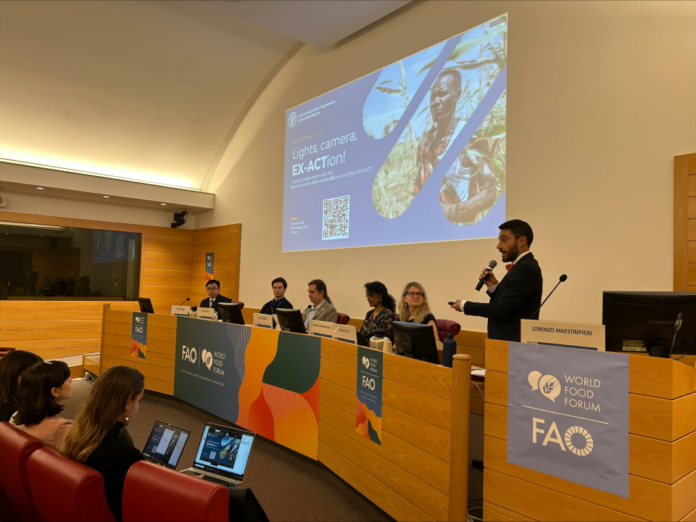FAO has launched the new-look EX-ACT (Environmental eXternalities ACcounting Tool) during a special event on the sidelines of the 2024 Hand-in-Hand (HIH) Investment Forum. The new digital version of this trusted climate change mitigation tool offers enhanced features to measure and track greenhouse gas (GHG) emissions and carbon sequestration for planned, ongoing or completed agrifood activities, projects, or policies.
At the event, the team of climate-change economists behind EX-ACT revealed a series of new features as the app goes digital. These include yearly accounting of activities, projects or policies, geospatial maps for visualizing climate data and agroecological zones, and improved user experience with faster and more intuitive navigation.
The launch of the new and improved EX-ACT web app comes hot off the heels of the FAO’s HIH Investment Forum on 14–17 October, where EX-ACT has been utilized by 15 countries seeking an assessment on their agrifood investment proposals, and just weeks away from the UN Climate Change Conference in Azerbaijan.
At the event opening, David Laborde, the Director of the Agrifood Economics and Policy Division that houses the EX-ACT team, said: “EX-ACT allows for reliable assessments of GHG emissions from agrifood investments or policies to help countries and international stakeholders with their global climate-change targets. Leveraging EX-ACT and its assessments fully aligns with FAO’s efforts for a better environment and Achieving SDG 2 without breaching the 1.5 °C threshold: A global roadmap”.
During the event, climate-change economists Joanna Ilicic, Lorenzo Maestripieri and Sravya Mamidanna highlighted how EX-ACT – formerly known as the EX-Ante Carbon balance Tool) – has evolved over its 15-year history to become the web-based app it is today. The team also detailed further enhancements expected in 2025, which include “biodiversity accounting” to measure, track and mitigate biodiversity loss in agrifood activities, projects, or policies.
The team was also joined on stage by Jigme Tenzin from FAO Bhutan and Jack Rossiter from the International Fund for Agricultural Development (IFAD), who both gave practical overviews of the tool being applied in the field. Jigme spoke about how EX-ACT has been used in the country for assessments on lands growing quinoa, strawberry, asparagus, coffee, arecanut, black pepper, citrus mandarin, buckwheat, and rainbow trout. The team has also trained over 40 people from the Ministry of Finance, Ministry of Agriculture and Livestock, Cabinet secretariat, Bhutan Chamber of Commerce and Industry.
Jack Rossiter, Senior Technical Specialist and Manager of the Adaptation for Smallholder Agriculture Programme (ASAP) at IFAD, also joined the panel to discuss the long-standing collaboration between IFAD and FAO on EX-ACT, which has been used by the international financial institution on 85 projects in 58 countries, with an estimated potential of 181 milliontonnes of GHG “fluxes” averted over 20 years thanks to EX-ACT assessments.
The event gathered over 60 people both in person at FAO Headquartersin Rome and online, with people connecting from Austria, Ethiopia, Finland, France, Germany, Kyrgyzstan, Mozambique, the Netherlands, Senegal, and Switzerland.








